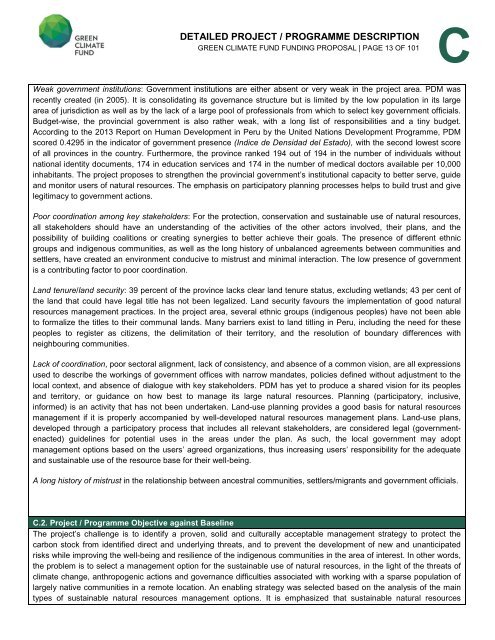proposals – Addendum
bf35cb34-05cf-4f96-a8fb-0adfa54cc3c9
bf35cb34-05cf-4f96-a8fb-0adfa54cc3c9
Create successful ePaper yourself
Turn your PDF publications into a flip-book with our unique Google optimized e-Paper software.
DETAILED PROJECT / PROGRAMME DESCRIPTION<br />
GREEN CLIMATE FUND FUNDING PROPOSAL | PAGE 13 OF 101<br />
C<br />
Weak government institutions: Government institutions are either absent or very weak in the project area. PDM was<br />
recently created (in 2005). It is consolidating its governance structure but is limited by the low population in its large<br />
area of jurisdiction as well as by the lack of a large pool of professionals from which to select key government officials.<br />
Budget-wise, the provincial government is also rather weak, with a long list of responsibilities and a tiny budget.<br />
According to the 2013 Report on Human Development in Peru by the United Nations Development Programme, PDM<br />
scored 0.4295 in the indicator of government presence (Indice de Densidad del Estado), with the second lowest score<br />
of all provinces in the country. Furthermore, the province ranked 194 out of 194 in the number of individuals without<br />
national identity documents, 174 in education services and 174 in the number of medical doctors available per 10,000<br />
inhabitants. The project proposes to strengthen the provincial government’s institutional capacity to better serve, guide<br />
and monitor users of natural resources. The emphasis on participatory planning processes helps to build trust and give<br />
legitimacy to government actions.<br />
Poor coordination among key stakeholders: For the protection, conservation and sustainable use of natural resources,<br />
all stakeholders should have an understanding of the activities of the other actors involved, their plans, and the<br />
possibility of building coalitions or creating synergies to better achieve their goals. The presence of different ethnic<br />
groups and indigenous communities, as well as the long history of unbalanced agreements between communities and<br />
settlers, have created an environment conducive to mistrust and minimal interaction. The low presence of government<br />
is a contributing factor to poor coordination.<br />
Land tenure/land security: 39 percent of the province lacks clear land tenure status, excluding wetlands; 43 per cent of<br />
the land that could have legal title has not been legalized. Land security favours the implementation of good natural<br />
resources management practices. In the project area, several ethnic groups (indigenous peoples) have not been able<br />
to formalize the titles to their communal lands. Many barriers exist to land titling in Peru, including the need for these<br />
peoples to register as citizens, the delimitation of their territory, and the resolution of boundary differences with<br />
neighbouring communities.<br />
Lack of coordination, poor sectoral alignment, lack of consistency, and absence of a common vision, are all expressions<br />
used to describe the workings of government offices with narrow mandates, policies defined without adjustment to the<br />
local context, and absence of dialogue with key stakeholders. PDM has yet to produce a shared vision for its peoples<br />
and territory, or guidance on how best to manage its large natural resources. Planning (participatory, inclusive,<br />
informed) is an activity that has not been undertaken. Land-use planning provides a good basis for natural resources<br />
management if it is properly accompanied by well-developed natural resources management plans. Land-use plans,<br />
developed through a participatory process that includes all relevant stakeholders, are considered legal (governmentenacted)<br />
guidelines for potential uses in the areas under the plan. As such, the local government may adopt<br />
management options based on the users’ agreed organizations, thus increasing users’ responsibility for the adequate<br />
and sustainable use of the resource base for their well-being.<br />
A long history of mistrust in the relationship between ancestral communities, settlers/migrants and government officials.<br />
C.2. Project / Programme Objective against Baseline<br />
The project’s challenge is to identify a proven, solid and culturally acceptable management strategy to protect the<br />
carbon stock from identified direct and underlying threats, and to prevent the development of new and unanticipated<br />
risks while improving the well-being and resilience of the indigenous communities in the area of interest. In other words,<br />
the problem is to select a management option for the sustainable use of natural resources, in the light of the threats of<br />
climate change, anthropogenic actions and governance difficulties associated with working with a sparse population of<br />
largely native communities in a remote location. An enabling strategy was selected based on the analysis of the main<br />
types of sustainable natural resources management options. It is emphasized that sustainable natural resources


